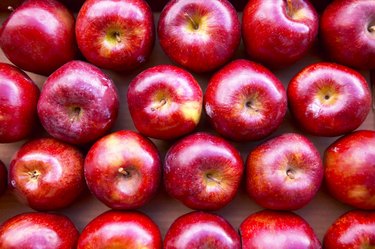
Cane sugar and fructose are both simple carbohydrates that provide 4 calories per gram. Although cane sugar, or sucrose, differs slightly from fructose in terms of molecular structure, both are sugars that add calories without improving the nutritional composition of the food. Your body uses both cane sugar and fructose for immediate energy if needed, or stores them for later.
Cane Sugar
Video of the Day
An average sugar cane stalk yields around 0.3 lb. of sugar, according to the University of Florida. Cane sugar can be refined and marketed as white table sugar or refined and flavored with molasses as brown sugar. Cane sugar is also sold unrefined as raw cane sugar. Raw cane sugar contains natural nutrients that the refining process strips away.
Video of the Day
Fructose
Fructose occurs naturally in foods such as fruit and honey. Manufacturers derive fructose from foods such as corn. Fructose accounts for roughly 8 to 10 percent of human energy intake, according to Georgia Highlands College. This includes natural sources of fructose as well as fructose added to foods. Fructose tastes around 1.2 times sweeter than table sugar, and manufacturers sometimes use it as a sweetener in processed foods.
Chemical Composition
Both fructose and cane sugar are simple sugars. A simple sugar contains one or two sugar molecules. Fructose is a monosaccharide, meaning that it consists of a single sugar molecule. Cane sugar is sucrose, a double sugar or disaccharide, which consists of two sugar molecules, glucose and fructose. Crystalline fructose, not to be confused with high-fructose corn syrup, contains only fructose molecules. High-fructose corn syrup, on the other hand, has a similar composition to cane sugar in that it contains both glucose and fructose.
Considerations
In the Dietary Guidelines for Americans 2010, the U.S. Department of Agriculture points out that added sugars in general account for around 16 percent of energy intake in the typical American diet. Added sugars include fructose, cane sugar or other sugars such as molasses, honey, maple syrup and corn syrup solids. Everyone should limit daily calories from added sugars to no more than 150 calories for men and 100 calories for women, according to the American Heart Association.
- University of Florida; An Overview of Florida Sugarcane; L. E. Baucum, et al.
- Elmhurst College: Sucrose
- Georgia Highlands College: Carbohydrates
- Calorie Control Council: Facts About Fructose
- MedlinePlus: Carbohydrates
- U.S. Department of Agriculture; Dietary Guidelines for Americans 2010: Chapter 3: Foods and Food Components to Reduce; January 2011
- American Heart Association: Sugars and Carbohydrates
- MayoClinic.com; Added Sugar: Don't Get Sabotaged by Sweeteners; April 2011
- Elmhurst College: Fructose